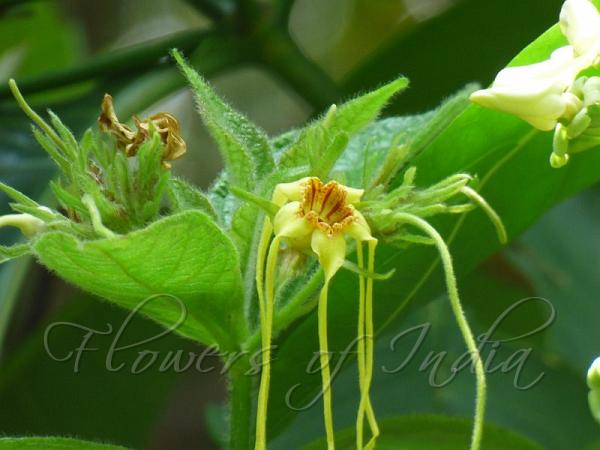|
| Kombe Arrow-Poison |
|

|

| File size | 109105 |
| Original date | 4/24/18 11:16 AM |
| Resolution | 800 x 600 |
| Flash | Flash did not fire, auto |
| Focal length | 154.9mm |
| Exposure time | 1/100s |
| Aperture | 5.6 |
| Focus Distance | |
| Metering Mode | Multi-segment |
| Camera make | Panasonic |
| Camera model | DMC-FZ70 |
| Sensor type | OneChipColorArea |
|
|
|
|
Photo: |
Botanical name: Strophanthus kombe Family: Apocynaceae (Oleander family)
Synonyms: Strophanthus hispidus var. kombe
Synonyms: Strophanthus hispidus var. kombe
Kombe Arrow-Poison is a is a deciduous vine, that can
also grow as a shrub. Flowers are cream colored, yellow at the base
with red spots and streaks inside. The genus name Strophanthus
is derived from the Greek strophos (a twisted cord or rope) and
anthos (a flower), thus describing the main peculiarity of the
flowers, the petals ending into long, tail-like segments. There is a
thick layer of hair on the outside towards the top, while the inside of
the flower has very few hairs. The stamen is found near the base of the
flower tube. The pistil contains a style a few millimeters in length,
with a ring-like head surrounding a minuscule stigma. Flowers are found
in clusters of 1-12. The plant generally occurs as a climbing vine that
climbs us to the top of tall trees. It can grow up to 3.5 meters, with
a stem that grows up to 10 cm in diameter. The bark is a reddish brown,
with dark brown, grey or black lenticels. Roots are thick and fleshy.
The papery leaves are simple, and found in opposite arrangement. The
young leaves are exceptionally hairy on both sides, but as they age,
the top of the leaves become smooth. The fruit of the flower contains
two seedpods that narrow towards the tip and end in a knob of various
sizes. It has two thick and hard-walled compartments containing many
spindle shaped seeds. Kombe Arrow-Poison is native to tropical East
Africa. Can be found wild in some parts of India.
Medicinal uses: Kombe Arrow-Poison is known
for its historical use as a source of arrow poison. Today it is used
medicinally to treat heart failure. The plant has been used for two
extremes, ending a life and saving a life, so proper dosage is crucial
when using this plant medicinally. Cardiac glycosides extracted from
the seeds reduce the heart rate but increase the force and efficiency
of the contractions.
Kombe Arrow-Poison is known
for its historical use as a source of arrow poison. Today it is used
medicinally to treat heart failure. The plant has been used for two
extremes, ending a life and saving a life, so proper dosage is crucial
when using this plant medicinally. Cardiac glycosides extracted from
the seeds reduce the heart rate but increase the force and efficiency
of the contractions.
Medicinal uses:
 Kombe Arrow-Poison is known
for its historical use as a source of arrow poison. Today it is used
medicinally to treat heart failure. The plant has been used for two
extremes, ending a life and saving a life, so proper dosage is crucial
when using this plant medicinally. Cardiac glycosides extracted from
the seeds reduce the heart rate but increase the force and efficiency
of the contractions.
Kombe Arrow-Poison is known
for its historical use as a source of arrow poison. Today it is used
medicinally to treat heart failure. The plant has been used for two
extremes, ending a life and saving a life, so proper dosage is crucial
when using this plant medicinally. Cardiac glycosides extracted from
the seeds reduce the heart rate but increase the force and efficiency
of the contractions. | Identification credit: Aarti Khale, Shrikant Ingalhalikar | Photographed in Lalbagh Botanical Garden, Bangalore. |
• Is this flower misidentified? If yes,